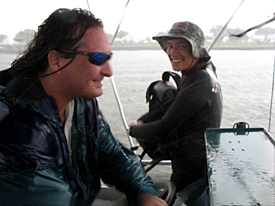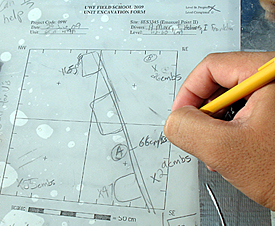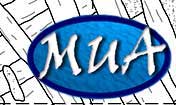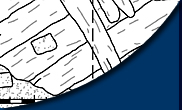
Storms, Planes, and Schooner Frames
July 6-10, 2009
By Chris Dvorscak, Gary McMullen , and Scott Sorset

The storms in Pensacola Bay gather quickly so we keep vigilant with our eyes sharp.
Unfortunately for the new students, that are just making the transition into underwater from the terrestrial field school, the week started off with bad weather. However, not all was lost because when work cannot be done in the field there is always work to be done in the lab. As a group, we gained a lot of ground on cataloguing and recording all the artifacts we have found so far on EPII. Students handled many different types of artifacts such as ceramic olive jar sherds, chicken, rat, and fish bones, and wooden treenails that were used to fasten ship timbers together. All the artifacts must be measured, weighed, and sketched thoroughly for future reference. Also, a group of students got to work with Wayne Abrahamson to help preserve a wooden knee with a chemical known as Polyethylene Glycol or PEG, that is necessary for conserving wooden artifacts of this age that have been immersed in water for so long. This chemical helps to fill in the gaps in the damaged cell walls of the wood.
Due to this week’s consistently bad weather, the crew was again unable to dive on Tuesday. Weather reports that morning had 3-4 foot seas with a small craft advisory and thunderstorms. The day was not a total loss however, as the UWF Maritime Archaeology crew had the privilege of getting a special tour and lecture on the salvaging and restoration of naval aircraft at the Museum of Naval Aviation. Our guide was Captain Ed Ellis (USN Ret.), a former JAG officer who is now the corporate secretary for the Naval Aviation Foundation and helps oversee and coordinate the salvage and restoration operations at the museum.
After a fairly thorough lecture on salvage and restoration of aircraft by Captain Ellis in the main lobby, he proceeded to take us to the underwater treasures of Lake Michigan exhibit which features naval aircraft found and recovered from the Great Lakes. During the Second World War, with the threat of German U-boats off the American seaboard, the Navy had two aircraft carriers assigned to the Great Lakes in order to facilitate the training of Naval Aviators. Two of these aircraft, a F4F Wildcat fighter and a SBD Dauntless dive bomber, were on display at the exhibit exactly as they had been found and recovered from the bottom of Lake Michigan.
Most aircraft recovered by the museum are not left in their “original” state. The majority of those found and salvaged throughout the world (the museum is currently acquiring a rare Devastator torpedo bomber from the Marshall Islands) are restored to nearly flyable condition at the restoration hangar directly behind the museum. Using a crew of retired military aircraft mechanics, Marine and Navy students waiting to attend aircraft maintenance schools at NAS Pensacola, government employees, and volunteers, the Naval Aviation Foundation has the aircraft rebuilt from ground to wingtips using 1940’s era parts (if available) or parts fabricated right there in their numerous shops. The restoration hangar has a full machine shop, sheet metal shop, upholstery shop, metal-casting shop and armory and some other shops as well, including one where they can build new canopies. The engines are entirely rebuilt, to include the spark plugs, pistons, etc. Wings and fuselage are patched, sanded, primed and painted using the original era color schemes. Interiors have the gauges fixed and the seats reupholstered. The entire process is quite impressive.
The highlight of the tour was to see one of the restoration projects up close. This particular aircraft, a Coronado seaplane, was the personal aircraft used by Admiral Chester Nimitz, commander of all US Naval Forces in the Pacific during the Second World War. It also had the honor of being the first American aircraft to land in Japan following the conclusion of the war. Following the war the Coronado was then bought by Howard Hughes, who used it to train himself in flying seaplanes before taking up his famous (or infamous) Spruce Goose. The Naval Aviation Foundation later acquired it after it had been sitting in a grass field in California. The aircraft is currently undergoing its full restoration process, with the engines sitting on mounts being rebuilt, its tail section sitting beside it being repainted and assembled, and the fuselage having the interior insulation and other items fixed or replaced. Though most of us were disappointed in not diving Tuesday, we all enjoyed this unique opportunity offered by Naval Aviation Foundation.

Field director Greg Cook and student Helen Welch run from the tempest at the B-Street Schooner site.
By Wednesday, the weather cleared up enough in the morning for the group to head out to EPII, and even though afternoon thunderstorms cut our day shorter than usual it was still a successful day. A team of students and supervisors also went to the B-Street site to continue dredging our first unit on the wreck. Completing two levels there, glass shards, nails, and concretions were amongst the initial findings. The conditions on B-Street are quite favorable compared to those of EPII, for the wreck is in only about 5 to 7 feet of water, and the visibility is much better. Over on EPII, the opening of a new unit in the stern section of the ship proved to be very exciting as it is exposing more hull structure and many new artifacts.
On Thursday the crew had a very successful day. Two separate groups went out, one to the EPII wreck and the other to B Street Schooner. The weather was particularly pleasant in the morning with calm seas and clear skies. A much better situation than what occurred previously during the week. The B Street Schooner crew, led by Greg Cook and Scott Sorset, also had a successful day with dredging on one of the units and discovering a few interesting artifacts, such as wooden boards with small brass tacks.
Upon reaching the barge the first teams went into the water, with one team working the north units and another team working the south units. The new unit in the south put in Wednesday at 84N 499E was opened and dredging was begun. On the second dive, Team 2 consisting of Andy Marr and Gary MacMullen, with Colleen Reese as supervisor, continued the work started on unit 84N 499E. After dredging through most of the ballast level and finding large pieces of slag the team reached what appears to be the sternpost of the vessel; an exciting discovery to say the least. On the third dive work continued in the north unit and some work was conducted amidships. The fourth and final dive the dredges were broken down.

Student cleans up underwater drawing on surface (Large View).
Friday brought another determined day of dredging on EPII, combined with some target diving to hopefully find the elusive EPIII was a fulfilling way to end a great week. Much ground was gained in both the stern and the amidships units since the group is working harder than ever to get through the ballast level of the site. Peculiar wood pieces were plotted in the amidships unit that could prove to be part of a barrel, and both units are still uncovering lots of bone, lead-glazed ceramics, resin, dunnage, insect remnants, and much more. Also, the presence large quantities of coral is proving very interesting. Specialists may be able to uncover where these coral types are from, and if they are of a gulf variety, may prove that all of the artifacts recovered on the shipwreck were loaded from Vera Cruz, Mexico.
The excellent circle searching skills of the students allowed them to find the anomaly on the seafloor that they had set out to. They confirmed that there is a large stone on the bottom of the bay that may be ballast, but further investigation must take place to fully understand why it is located on the Bay floor. More ballast stones may be located at a deeper depth than probing can confirm. We are all excited to see what else this target and the week to come may produce.
Please feel free to contact us if you have any questions or concerns at: mua@keimaps.com.
Return to Project Journal home page.

